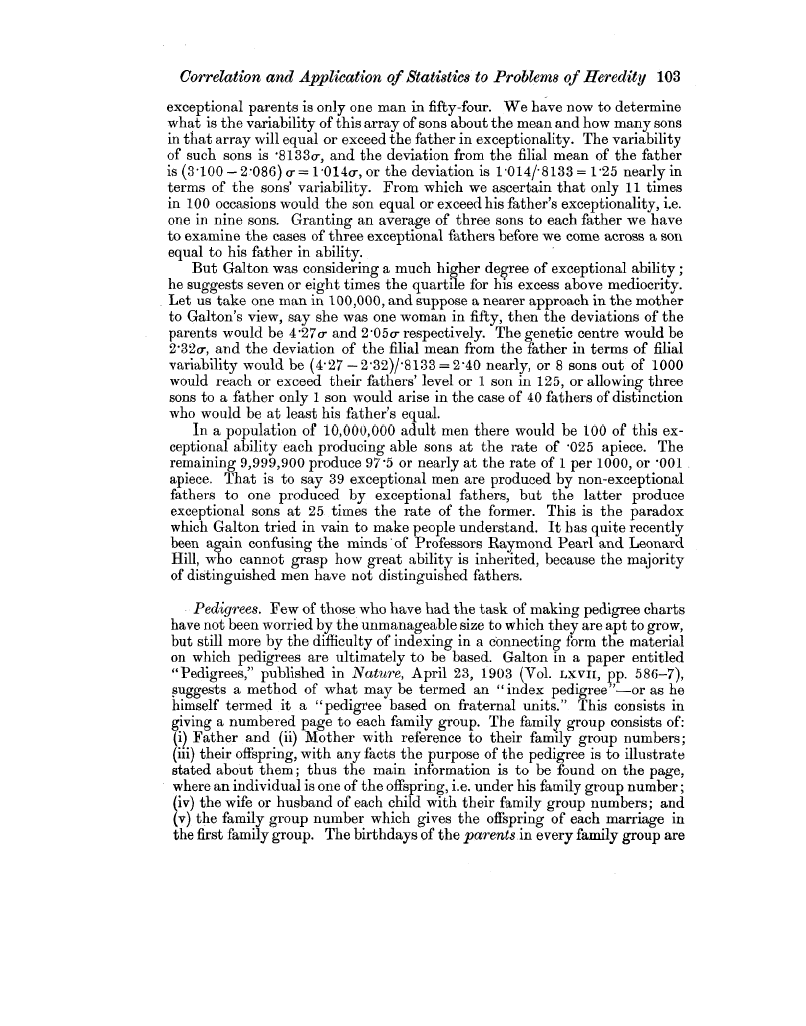| ||||||

OCR Rendition - approximate
Correlation and Application of Statistics to Problems of Heredity 103 exceptional parents is only one man in fifty-four. We have now to determine what is the variability of this array of sons about the mean and how many sons in that array will equal or exceed the father in exceptionality. The variability of such sons is •8133o-, and the deviation from the filial mean of the father is (3.100 - 2,086) o = 1.014or, or the deviation is 1-014/- 8133 = 1.25 nearly in terms of the sons' variability. From which we ascertain that only 11 times in 100 occasions would the son equal or exceed his father's exceptionality, i.e. one in nine sons. Granting an average of three sons to each father we have to examine the cases of three exceptional fathers before we come across a son equal to his father in ability. But Galton was considering a much higher degree of exceptional ability ; he suggests seven or eight times the quartile for his excess above mediocrity. Let us take one man in 100,000, and suppose a nearer approach in the mother to Galton's view, say she was one woman in fifty, then the deviations of the parents would be 4.27a- and 2.05o- respectively. The genetic centre would be 2.320, and the deviation of the filial mean from the father in terms of filial variability would be (4.27 - 2.32)•8133 = 2'40 nearly, or 8 sons out of 1000 would reach or exceed their fathers' level or 1 son in 125, or allowing three sons to a father only 1 son would arise in the case of 40 fathers of distinction who would be at least his father's equal. In a population of 10,000,000 adult men there would be 100 of this exceptional ability' each producing able sons at the rate of •025 apiece. The remaining 9,999,900 produce 97.5 or nearly at the rate of 1 per 1000, or •001 . apiece. That is to say 39 exceptional men are produced by non-exceptional fathers to one produced by exceptional fathers, but the latter produce exceptional sons at 25 times the rate of the former. This is the paradox which Galton tried in vain to make people understand. It has quite recently been again confusing the minds " of Professors Raymond Pearl and Leonard Hill, who cannot grasp how great ability is inherited, because the majority of distinguished men have not distinguished fathers. Pedigrees. Few of those who have had the task of making pedigree charts have not been worried by the unmanageable size to which they are apt to grow, but still more by the difficulty of indexing in a connecting form the material on which pedigrees are ultimately to be based. Galton in a paper entitled "Pedigrees," published in Nature, April 23, 1903 (Vol. Lxvir, pp. 586-7), suggests a method of what may be termed an "index pedigree "-or as he himself termed it a "pedigree based on fraternal units." This consists in giving a numbered page to each family group. The family group consists of: (i) Father and (ii) Mother with reference to their family group numbers; (iii) their offspring, with any facts the purpose of the pedigree is to illustrate stated about them ; thus the main information is to be found on the page, where an individual is one of the offspring, i.e. under his family group number; (iv) the wife or husband of each child with their family group numbers; and (v) the family group number which gives the offspring of each marriage in the first family group. The birthdays of the parents in every family group are
|